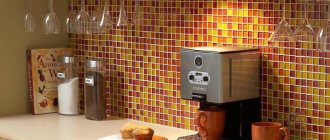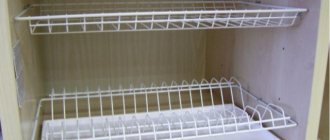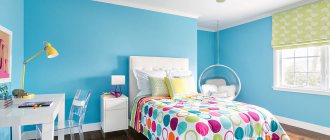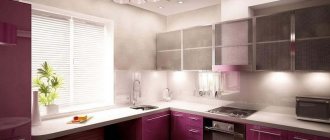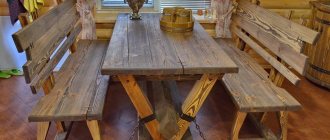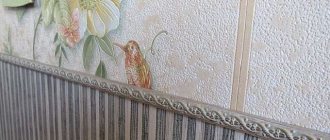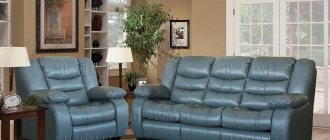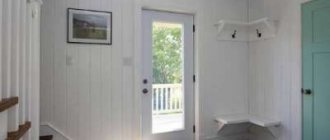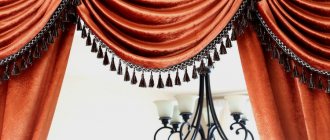Types of shelf brackets
There are many types of shelf brackets today. This diversity is due to the different types and designs of shelves for which the holders are intended. Also, the type of bracket depends on the interior of the room.
Most bracket designs use the lever principle, where a longer piece secures smaller screws in the wall. Thanks to this, the screws completely hold the entire shelf.
Important! Standard brackets for shelves made of wood or metal are designed for a weight of up to 30 kg, including the shelf itself. A standard wooden shelf can support exactly this weight.
Mounting methods
Let's start with the fact that you can only get by without a drill or hammer drill as a tool for installing shelves when installing light decorative structures on soft walls, which can simply be penetrated with a self-tapping screw and a screwdriver.
But usually you need to use an auxiliary power tool. Especially when you need to install a heavy shelf that will be subject to a significant load on the wall:
- from plasterboard;
- made of concrete;
- brick;
- from aerated concrete;
- from foam blocks;
- wooden, etc.
The first thing you need to pay attention to is the material from which the walls are made. Here it will become clearer to you whether you can do without drilling the wall or not.
When planning how to mount shelves on a wall, the type or method of fixation plays a key role. To do this, you need to study the installation options to choose the most acceptable and suitable for you.
- No visible fastenings. This is a hidden fastener that allows you to make the fastenings invisible, and make the shelves themselves light and elegant. Suitable for brick, concrete, foam and aerated concrete walls. If this is a plasterboard partition less than 10 cm thick, it is better not to use installation with invisible fasteners;
- On brackets. It will not be possible to hide them, and therefore the brackets will remain visible. To save money, some are mounted on plastic or metal corners. But to create a beautiful interior, it is better to use appropriate brackets. Visible brackets do not suit all interior styles;
- Using holders. Relevant for shelves made of glass. There are rubber or silicone based gaskets that protect the glass from destruction. Shelf holders have different types and configurations, including suction cup options;
- On hinges and corners. The most common and easiest to implement method. Using hinges and corners of certain sizes, you can reduce or increase the load that the shelf can withstand. Fastening is carried out using guides or on metal stands;
- Through the bar. Relevant for hollow walls, where it is not possible to fix the shelf directly to the wall. First, a metal or wood strip is mounted, and the shelf itself is fixed to it. Suitable for those whose walls are made of thin plasterboard, hollow brick and other similar materials. Here it is important to fix the bar at the maximum number of points. Some fasteners will go into the void, but others will definitely catch. It will not be superfluous to know in advance about the location of the partitions.
The greatest number of questions are raised by fastening with invisible fasteners, as well as working with plasterboard walls. They are proposed to be considered separately.
The nuances of invisible fasteners
It makes no sense to talk in detail about this method of installing wall shelves if you carefully understand only 3 main issues.
- Thickness of the wall used. Installation with invisible fastening is possible in situations where it is a brick or concrete wall. Moreover, the concrete partition must have a minimum thickness of 105 mm, and the brick partition - 250 mm. If the parameters are smaller, you will have to use additional elements. Cinder block and plasterboard walls with a thickness of less than 100 mm are suitable only for hanging decorative shelves on which there is no load or it is minimal;
- The thickness of the shelf itself. It is not recommended to use shelves that are too thin or too massive. The material should not sag, must be dry and have a high-quality finish. If the load on the shelf is minimal, the thickness is selected from 30 mm. If the shelf is for books and other heavier objects, the thickness is taken in the range of 45-60 mm;
- Fastening. Fasteners are selected based on point 2 and the purpose of the shelf itself. Invisible fastenings are made in the form of a hinged loop and a rod. The loop is mounted on the back of the shelf and markings are made. A hole is made in the wall and a plug is inserted inside. Next, all you have to do is screw in a screw or self-tapping screw to the desired depth and attach the hinges to them.
Be sure to consider the expected load to avoid unnecessary problems. The higher the load, the more hidden fasteners need to be used. Remember to have a sense of proportion.
Corner
This is the oldest and most common type of bracket. It consists of two long planks connected at an angle. One strip is attached to the wall, the other to the bottom of the shelf.
Reinforced brackets for shelves are also made in the form of corners. For greater strength and increased load, the following techniques are used:
- Installing a horizontal jumper between two or three brackets
- Installing the top and bottom horizontal jumpers
- Solid Angle Bracket Design
Such mounts look quite massive, so they are best suited to classic, Scandinavian interiors and loft-style designs. They often have additional decor in the form of stucco, forged elements or openwork wood carvings. The simplest option for such fastenings is corners made of metal plates or profile pipes.
Fixing the shelf on the wall using hidden fasteners
Step 1. In order to fix a shelf on the wall using a hidden fastening option, you will need to prepare a hammer drill with a drill of a certain section, 2-3 special titanium pins, a building level, a square, a drill and a bit, the shelf itself, and a pencil for marking. The pin is a metal rod that is threaded on one side and smooth on the other. The threaded part will screw into the wall, and the smooth part will need to be fitted with a shelf. Typically the pin diameter is 10-12 mm. The drill is selected with the same diameter as the purchased titanium.
Special metal pin
Step 2. First of all, you need to apply markings to the shelf itself. By the way, you can make it yourself from any part of other furniture that has served its age, rather than buying new one. Using a ruler, you need to set aside the required distance from the end edge of the shelf. In this case, a distance of 12 cm was chosen.
Marking
Step 3. Having chosen the distance, you need, using a square and a pencil, to draw a line perpendicular to the plane of the shelf at the end where the hole for fastening will be drilled.
A perpendicular line is drawn at the end
Step 4. Next you need to find the middle of the end of the board and make a corresponding mark for the drill. It is important to understand that if the shelf consists of two sheets of chipboard glued together, then in this case it is better to drill a hole for fastening not in the middle, but with a slight offset towards one or another board (better - towards the bottom, it will be more reliable).
A mark is placed for the drill
Step 5. Similar markings must be applied on the opposite side of the shelf.
On the other side the same markings are applied
Step 6. Next, to the end of the shelf where the markings are applied, you need to attach a building level and directly on it make marks parallel to those previously applied to the board, as well as marking the edges of the shelf itself. The level cannot be moved while the marking is being transferred. Pencil marks can then be easily erased from the surface of the level, but this technique of transferring markings will make it easy to make markings for drilling holes in the wall.
The level cannot be moved while the marking is being transferred.
Marks are made at the level
Step 7. Then you need to select the approximate location of the shelf on the wall. Having applied it to the surface, you need to mark the boundaries of the product directly on the wallpaper with a pencil.
The shelf is attached to the wall
The boundaries of the shelf are marked
Step 8. Now you need to take a building level with markings and, attaching it to the wall in the selected and marked place, align and transfer the markings from the level to the wall, also using a pencil. In this way, you can easily and quickly make precise markings for the locations for drilling holes for the pins without unnecessary movements.
Transferring markings from level to wall
Step 9. Next, in the end part of the shelf, in the designated places, you need to drill holes for the pins. They should be the same depth as the length of the part of the pin on which the board will be placed.
A hole is drilled in the end
The depth of the hole should correspond to the part of the pin on which the shelf will be placed
Step 10. Now you need to take a hammer drill with a drill of the same diameter as the pin and make holes in the wall in accordance with the previously made marks. To prevent dust from concrete from falling onto the floor, it can be removed immediately using a switched on vacuum cleaner, the hose from which will be held by an assistant.
Holes are made in the wall
Step 11. Both titanium pins need to be installed in place, that is, inserted into the holes in the wall. If they are difficult to enter, you can carefully knock them out with a hammer or screw them into the wall using a key.
The pins are inserted into the holes
Step 12. All that remains is to put the shelf on the pins in the wall, aligning the holes with the metal fasteners. The shelf is installed. By the way, for better fixation, you can add a little glue to the holes of the shelf - then the connection will be even more reliable. This mounting option will allow you to achieve an effect where it seems as if the shelf is supported on the wall by itself.
The shelf fits onto the pins in the wall
Finished shelf without visible fasteners
Video - How to install a shelf with invisible fasteners
Pelican
This bracket is a mount with a part that looks like a pelican’s beak. With this beak, the bracket holds the shelf on the top and bottom sides. The lower part of the “beak” is much larger than the upper and looks like either a rounded elongated corner or a pelican’s beak.
- The shelf is fixed as follows: a horizontal part is installed on the large fixed part, and pressed on top with a small part of the beak. The small part is fixed with a screw-on element. This way the shelf is held quite securely.
- This is the most common bracket option for glass shelves, but these mounts can be used for other models. The advantage of the bracket is that it does not require much space under the shelf for its mounting.
These products are best suited for modern interiors in high-tech or modern style.
Shelf installation process
If you bought a shelf along with fastenings in a store, then the first thing you need to do is read the instructions on how to attach it. After all, some modern models have their own algorithm for attaching the shelf to the wall. You should especially carefully look at the instructions if the shelf has invisible fasteners, since in this case you need to use exactly those fasteners that the manufacturer recommends, otherwise you won’t be able to hide them.
Video on how to quickly hang a shelf Before attaching the shelf, you need to choose a place where it will be located. But you shouldn’t rush to drill into the wall right away; before fixing the rack, you need to measure everything so that it hangs beautifully and evenly.
The first thing you need to do this is to attach the shelf to the wall, and mark with a pencil on the wall the place where one of the bolts will be and put a mark there. Be sure to mark the center of the holes.
After this, we measure the distance between the centers of the fastenings, and from the mark made we measure the same, and put a vertical line.
Type of fastening
Then we simply apply a level to the wall and place a horizontal line in the area of the previous mark. The intersection of these lines will be the center of the bolt hole. You can check this by simply placing the shelf back against the wall.
Then you need to carefully make holes in the wall. To do this, you need to use a drill of the same diameter as the fasteners. If you take a smaller drill, the bolt simply won’t fit into the hole, and if you take a larger one, it will simply wobble and fall out.
In addition, when drilling, it is important to keep the drill level so as not to widen the hole, since in this case the fastening may also fall out, especially if you are using dowels rather than anchor bolts. Additionally, the hole should be deeper than the length of the mount you plan to use. After all, the drill does not remove all the debris from the hole, so you need additional space inside so that you can easily install the shelf.
When the mounting points are ready, you can hang the shelf. This also needs to be done carefully; if the fasteners do not fit into the hole, then you just need to lightly tap them with a hammer. First you need to install the shelf itself, and then install the fastenings. It's much simpler and easier.
Well, in the end you just need to tighten the anchor bolts or dowels until they stop.
The fasteners attached in this way will hold the shelf securely and firmly.
Hidden bracket
Here the shelf is held on the wall by a long, metal lever that fits inside the material of the structure. This lever is attached to the wall using a plate that is screwed using self-tapping screws. The plate is completely hidden under the shelf.
The main advantage of this type of metal shelf brackets is their invisibility. The shelves seem weightless, as if floating in the air.
These brackets are suitable for minimalist modern interiors or for traditional Japanese style designs.
Nuances to consider
When wondering how to hang shelves in the kitchen, many people don’t even realize how many seemingly unnoticeable details need to be taken into account.
- Initially, it is necessary to choose a high-quality product, because how firmly the structure will hold depends, among other things, on the quality of the model.
- Safety precautions. Heavy and unsafe tools must be handled in accordance with the instructions that come with them to avoid injury and accidents.
- Preparatory work. They must be fully completed and completed before the process of installing the shelves begins.
- Checking the work. Before you start using shelves and wall cabinets, installing dishes and other elements of kitchen utensils on them, you must check whether these furniture elements are securely fastened. The product must be able to withstand the load, otherwise there is a risk that it will fall, which could result in injury or damage to the cookware.
The shelves will hold up well if installed according to the diagram.
Bracket materials
The material of the shelf bracket depends primarily on its design. Hidden models are made only of metal, since appearance and design are not important here. For this design, it is important, first of all, to ensure high strength of the product with a small volume. Only metal can cope with this task.
Pelican-type brackets are most often made of chrome-plated steel alloys. This option looks very stylish. There are also wooden versions of “pelicans”.
Angle brackets are made from a variety of materials:
- Aluminum or steel. Such models can have an inconspicuous appearance and be almost invisible. Also, square-section profile pipes are often used for manufacturing.
- Cast iron. These brackets are designed for strong walls, as they themselves are quite heavy. However, they can easily withstand the heavy weight of the shelf - up to 50-60 kg. Cast iron products are often decorated with forged elements, which makes these massive parts quite elegant.
- Plaster stucco. Such models are made to order and often decorate rich classic interiors. They look massive, so they are only suitable for large rooms.
- Concrete. This material in the interior can act as a replacement for gypsum as it is stronger and more massive. You can also make brackets from it that will rest on metal reinforcement.
- Tree. They can have a simple design of two or three strips in the form of a corner, or they can have massive decorations in the form of carvings. This material will look organically in a Scandinavian or Japanese interior. Wooden shelf brackets are easy to make with your own hands. For beauty, they can be decorated with carvings, decoupage or varnished.
Advice. Wooden shelf brackets can be coated with bronze paint, this will give the structure an antique look, but at the same time the fasteners themselves will be very light. This option is perfect for the wooden walls of a country house, where it will go well with the fireplace grate.
Required materials and tools
Before you start attaching the shelves, you need to prepare everything you need.
- Both electric and hand drills will work. It is necessary to drill holes for fasteners. If the shelves need to be attached to a load-bearing wall, then the drill must have a special function for this, or you can use
- Hammer.
- Level.
- Screwdriver.
- Hammer.
- Clamps. This tool will come in handy if you need to combine several drawers together to create the illusion of a monolithic structure.
- If you plan to install it on anchors, you need to have a suitable size wrench on hand.
- Fastening elements. As a rule, screws are included with cabinets from the manufacturer. You also need screws and dowels. If you need to fasten cabinets to each other, you can purchase special ties.
Before hanging shelves in the kitchen, make sure you have all the necessary tools.
How to choose a bracket
In order not to make a mistake with which bracket is best to choose, you should consider several significant factors:
- How much weight is expected to be placed on the shelf? Glass shelves can withstand the least weight – up to 5 kg. Regular wooden shelves can hold 30 kg.
- What material is the wall made of? For a wooden or plasterboard wall, you should not choose heavy metal structures.
- What will be the width and length of the shelf? The horizontal fastening bar should not extend beyond the edges of the shelf. The difference between the width of the shelf and the length of the horizontal bar should be no more than 10 cm.
In addition to technical features, the interior style should also be taken into account. The bracket should be in harmony with the overall design of the room.
In some cases, fastenings can even be separate decorative elements that give the interior originality and uniqueness.
Decorative fastening for shelves to the wall
In almost any hypermarket or construction market that sells finishing materials, you can buy fasteners for shelves to the wall - from the simplest consoles to decorative holders of interesting shapes. Shelf mounts are also found in various online stores, chains such as Leroy, Ikea, etc.
Consoles and brackets
The simplest and cheapest console shelf holders are a metal “corner” bracket, which can be equipped with a plastic cover. Consoles are selected according to the depth of the wall shelf. For a shallow shelf on which you plan to place some light small items, you can choose the smallest brackets, with a shoulder of 100-150mm. If you intend to attach the shelf to the wall of a workshop or dressing room with a large load, you should choose a “more powerful” option.
There are interesting cantilever brackets with decorative designs, coated with matte and stainless steel, ferrous metal, gold, brass, bronze, nickel, etc. The choice is large and there is always the opportunity to choose fasteners for shelves to the wall of the desired color and design to match the interior.
For many brackets for fastening open shelves, the manufacturer specifies the load-bearing capacity - when choosing, you can focus on this characteristic. It is also worth considering the length of the shelf. To prevent a wall shelf made of chipboard or wood from sagging, I recommend installing fasteners every 600-700mm. That is, if the shelf is longer than 800mm, then it makes sense to attach it to the wall using three cantilever brackets.
Pelicans (toucans)
The principle of console and bracket type holders is based on creating a stop in the form of a shoulder under the surface of the wall shelf. Pelicans or, as they are also called, toucans, use a different method of fastening - they “grasp” the shelf in thickness. Actually, the name came from the similarity of the shape of the fastener with the beak of a toucan and pelican.
Pelican (toucan) type holders are mainly designed for attaching glass shelves to the wall, since they extend to a limited thickness - on average 4-10mm, no more. This is ideal for securing a glass shelf to the wall, but not sufficient for most wooden shelves. There are also special gaskets inside the “beak” to prevent damage to the glass surface during the process of adjusting the fasteners.
Pelican holders of greater thickness, about 16-18mm, are quite large and cost more than consoles and brackets. But they look neat and provide a fairly reliable attachment to the wall. They are also selected according to the manufacturer’s characteristics; each “toucan” size is designed for a certain holding weight and shelf depth.
Pegboards and holds
This type of fastener for open wall shelves is more suitable for installation in dressing rooms, pantries, workshops, etc. But with the trend of using industrial styles in home and kitchen interiors, pegboards and hooks are also gaining popularity.
A pegboard is a perforated panel on which hooks and holders for shelves and containers are installed in random order. It is quite suitable for installing bookshelves above a desk in a nursery or personal office. It can be found in the interior design of the kitchen and living room, it looks quite original.
The principle of attaching shelving shelves to hooks is taken from warehouse and retail equipment. In variations for dressing rooms, it is a vertical rail with holes for installing consoles. And shelves are already attached to these consoles.
Just like in pegboards, you can rearrange the shelves and add other accessories and holders as needed.
Photos of all types of brackets and fastenings for shelves
Fastening with anchor bolts - Reliable!
One of the most popular fastening methods is the anchor bolt method. This method is known to almost everyone who works with drywall, but it is used extremely rarely. This design consists of fastening directly into the wall through plasterboard sheathing with anchor bolts.
This fastening method is used only if the distance between the wall and the plasterboard is small!
Step-by-step instruction
- A through hole is drilled in the drywall in the place where the drywall rests on the profile;
- Afterwards, a hole is drilled in the wall through the already prepared holes;
- The anchor is mounted into the wall, through the plasterboard sheet and clamped.
- We use an anchor to attach the shelf, or we attach a special fastening to it, for example, a bracket.
This mount is the highest quality and strongest.
Features and Disadvantages
Among the features of this method are:
- Durability;
- Ability to withstand heavy loads;
- It practically relieves the plasterboard sheet of stress.
But there are also some disadvantages, and not a single design can do without them:
- Installation can only be carried out when the structure is built on a metal frame;
- Labor-intensive during arrangement, due to the need to provide holes in the drywall, and then in the building panel;
- The cost is quite high, compared to previous methods;
- Under global loads, or an incorrectly selected anchor, it can destroy not only the plasterboard fence, but also the building panel.
A wide range of special elements helps to perform fastening reliably and quickly. In our article we will tell you about the most common and most effective products for cellular materials.
Dowel for screw
Designed for installation in aerated concrete. It consists of nylon dowels in the shape of a spiral. When screwed into aerated concrete, it does not crumble its structure. The wide thread on the outer surface creates a reliable connection with the base material. During installation, you can use wood screws, universal screws, screws, bolts and studs.
Scope of application:
for fastening radiators, ventilation, air conditioners and plumbing.
- Drill a hole, the drill should be 2 mm smaller than the diameter of the dowel, clean it from dust.
- Install the anchor into the hole using the RBT installation tool or a hex wrench. A low-speed screwdriver with an RNZ bit is also suitable for installation.
- Tighten the screw.
Plastic dowel
Equipped with spiral-like ribs for the best grip on the surface. The main advantage is absolute resistance to corrosion. For fastening, it is recommended to use universal self-tapping screws, screws, wood screws, possibly with metric fasteners.
Scope of application:
when installing wooden and metal facade subsystems, windows, doors, suspended ceilings, sanitary equipment, pipelines.
- Drill a hole for the dowel plug. Use a drill with a diameter equal to the dowel body.
- Install the dowel into the hole.
- Screw in the screw.
Metal dowel (crocodiles, herringbone)
The most popular fastener to gas silicate walls. It is a steel tube with four blades that are notched. When screwing in the screw, the blades expand, the internal threads provide reliable adhesion to the porous material of the block. Metal dowels are coated with yellow zinc to prevent corrosion. Used in conjunction with conventional wood screws, self-tapping screws and screws with metric threads.
Scope of application:
for fastening plumbing systems and mounting profiles, suspended ceilings, pipes, kitchen furniture, ventilation equipment, as well as foam blocks to a wall made of other materials.
- Make a hole in the wall using a non-impact method. Drill perpendicular to the plane of the base.
- The depth of the hole should be 1 cm greater than the length of the crocodile.
- Clean the hole thoroughly to remove any sludge.
- Place the crocodile in the hole.
- Tighten the screw.
Drive-in reinforced anchors
Special fastening element with fire protection, certified for aerated concrete. It has four spacer plates and a square-shaped wedging element. When tightened, the cone is pulled into the square riving element, forming recesses in the hole. Installed using a hex wrench using a screwdriver or screwdriver.
Scope of application:
for installation of suspended ceilings, pipelines, railings, kitchen cabinets, cable trays, ventilation ducts, etc.
- Drill a hole.
- There is no need to further clean the hole.
- Drive a reinforced anchor into the hole.
- Tighten the anchor, the internal thread of the sleeve will begin to rotate, the cone will be pulled into the riving element.
- Once the optimal expansion of the anchor has been achieved, the hex key is released automatically.
- Insert the fastener.
